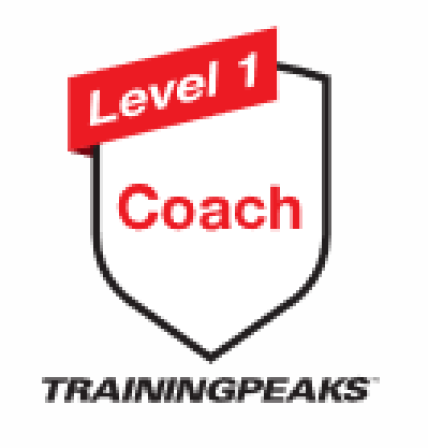Winter training for triathletes and endurance athletes
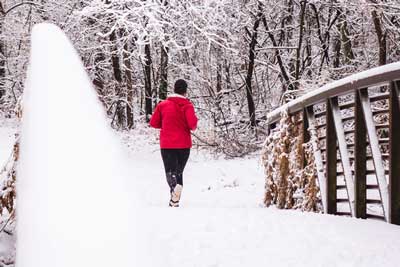 In winter, the summer athlete is being made. " This, or something similar, is the answer to the question about the goal of winter training. Therefore, if you want to perform at a high level in the summer, you should already start individual and targeted training in the winter. This provides the foundation for the coming season. The past season 2020 was characterized by many cancellations of races. For this reason, many athletes had problems with their motivation and the completion of the training plan. In the meantime, registrations for next year's events are starting up again. However, the organization of these competitions is still surrounded by many question marks. This uncertainty - which is characterized by Corona - can continue to result in motivation problems. At the same time, the upcoming winter training is a great opportunity. For sure, every athlete can think back to the reason why he or she started with his training. Often the reason can be found in the joy of exercising and improving your own performance. Exactly this intrinsic motivation can be brought out again in this phase of the year and thus new motivation can be developed. This phase of waiting will also come to an end and the competitions will start again. For this reason, an even stronger focus should be placed on winter training.
In winter, the summer athlete is being made. " This, or something similar, is the answer to the question about the goal of winter training. Therefore, if you want to perform at a high level in the summer, you should already start individual and targeted training in the winter. This provides the foundation for the coming season. The past season 2020 was characterized by many cancellations of races. For this reason, many athletes had problems with their motivation and the completion of the training plan. In the meantime, registrations for next year's events are starting up again. However, the organization of these competitions is still surrounded by many question marks. This uncertainty - which is characterized by Corona - can continue to result in motivation problems. At the same time, the upcoming winter training is a great opportunity. For sure, every athlete can think back to the reason why he or she started with his training. Often the reason can be found in the joy of exercising and improving your own performance. Exactly this intrinsic motivation can be brought out again in this phase of the year and thus new motivation can be developed. This phase of waiting will also come to an end and the competitions will start again. For this reason, an even stronger focus should be placed on winter training.
Periodization of training
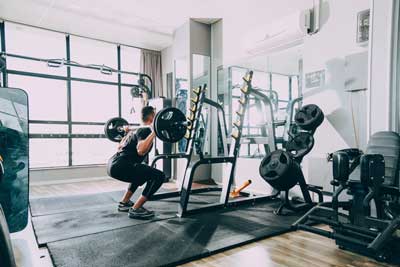 The training of summer athletes in winter is roughly divided into two phases: In the basic endurance I and II. In the two basic phases, work is done on improving basic aerobic endurance. Here, the training is primarily extensive. The main goal of this phase is to optimize the metabolism and to improve your technique. In this phase, the rule is therefore "a lot of technique with an increasing amount of base training". Nevertheless, intensive stimuli are also set in this phase from time to time in order to improve speed. However, you should keep in mind that the preparation for a competition and the adaptation to it will take some time. After all, you don't want to be in top shape in the spring, but rather in the summer. In the following second basic endurance phase II the training reaches a peak. Here you complete the largest volumes and the intensity to be achieved in this time of the year. In this way, a continuous increase of fitness takes place. This starts with low and high intensity workouts (basic endurance I and basic endurance II) and continues until shortly before the competition.
The training of summer athletes in winter is roughly divided into two phases: In the basic endurance I and II. In the two basic phases, work is done on improving basic aerobic endurance. Here, the training is primarily extensive. The main goal of this phase is to optimize the metabolism and to improve your technique. In this phase, the rule is therefore "a lot of technique with an increasing amount of base training". Nevertheless, intensive stimuli are also set in this phase from time to time in order to improve speed. However, you should keep in mind that the preparation for a competition and the adaptation to it will take some time. After all, you don't want to be in top shape in the spring, but rather in the summer. In the following second basic endurance phase II the training reaches a peak. Here you complete the largest volumes and the intensity to be achieved in this time of the year. In this way, a continuous increase of fitness takes place. This starts with low and high intensity workouts (basic endurance I and basic endurance II) and continues until shortly before the competition.
Strength training for endurance athletes in winter and summer, another focus should be on the underestimated athletic/strength and agility training. However, this focus establishes a substantial foundation your training. This improves the technique of all three individual disciplines and at the same time helps to prevent injuries.
Without alternative - training camps
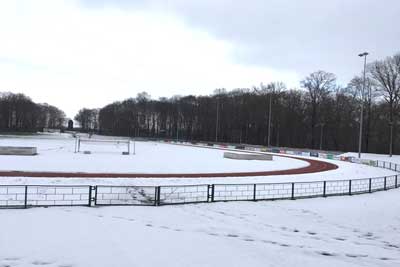 For the professional athletes, training camps are also an absolute inevitable option in the winter. Many of them complete several training camps in the winter and spring. They lay the foundation for their season through the numerous training camps.
For the professional athletes, training camps are also an absolute inevitable option in the winter. Many of them complete several training camps in the winter and spring. They lay the foundation for their season through the numerous training camps.
For amateur athletes, too, a training camp is a great way to achieve their athletic goals. The invaluable advantage is that as athletes, you can fully focus on your sport. In addition, a training camp allows you to escape the cold and finally get back out on the bike. This also has a significant effect on the mind and motivation. So you are immediately in a better mood in the training camp. It is simply more fun to run and cycle in the sun at 20 degrees than to have to run through puddles in the dark at 3 degrees and drizzle. Also the long basic rides on the bike on the indoor trainer are only conditionally fun at some point. In this respect, a training camp can have an all-round positive effect on the athlete. Professional athletes in particular make this advantage their own and it should also be increasingly taken advantage of by hobby athletes.
Indoor training - Smart trainer
In addition to the already mentioned aspects, bike training also takes a big place in the winter. Especially the training on a stationary bike trainer is very popular among many triathletes. The days are getting shorter and shorter and it is getting colder and colder outside, so there is no ideal cycling weather. In the meantime, there are numerous stationary bike trainer on the market. Cheap devices can be found already from 100 euros. A distinction is made between different types of bike trainer. The most realistic driving experience is provided by a free roller. With such a roller, the bike moves freely on the roller. However, a free roller already requires a pronounced driving skill. Therefore, such a role is suitable primarily mostly by professionals. The opposite of a free roller is a stationary bike. With a stationary bike, the rear wheel is firmly clamped onto the roller trainer. The advantage of this is that you can switch off your head on the stationary bike and simply step loosely in front of you. It is also easier to do intensive intervals on such a stationary bike. The so-called smart trainers are particularly popular. These can connect to an app via ANT+ or via a Bluetooth connection. Often, a stationary bike trainer is used with the popular Zwift training software. Here, the athlete can virtually ride through different worlds. Zwift resembles a game in this respect. For example, you can unlock different bikes. Nevertheless, there are numerous other training platforms on the market to which the Smarttrainer can connect. By connecting to such a platform, the athlete does not have the feeling of riding "alone". In addition, this significantly simplifies training planning.
Interval training
A stationary bike suites best for intensive interval training. Indoor training is significantly more exhausting and challenging than riding in the open air, a theoretical value of 30% can be considered realistic. Thus, on the stationary bike, one is neither distracted by traffic, nor by balance problems, nor by the landscape. Therefore, the athlete can fully concentrate on following cadence and intensity targets. Therefore, training on a stationary bike is comparable to running training on a track. For this reason, the training time per training session is usually limited to 90 minutes. This time is ideal for interval training. The aerobic capacity is trained by the well-planned combination of extensive and interval loads. The oxygen uptake can be greatly improved by various short intensive loads. A mandatory prerequisite for effective training on the stationary bike is the prior determination of individual FTP (Functional Threshold Power). Only then is it possible to accurately determine one's own training zones on the bike. In high-intensity interval training, the intervals take place above the FTP value (i.e. above 100% of the FTP).
Example workout for an aerobic training
Especially the longer aerobic rides (Z1) and thus the base training can become very monotonous on the stationary bike.
That's why all of our aerobic training sessions include a variety of variations and easier intervals.
Example 1
1. Warm up
- 5 min @ 70-82 % of Threshold Heart Rate
2. Repeat 7 times
I. Active - Z2 - 8 min @ 70-82 % of Threshold Heart Rate
II. Hard - Z3 - 1:30 @ 84-93 % of Threshold Heart Rate
III. Hard - Z4 - -30 sec @ 95-104 % of Threshold Heart Rate
3. Cool Down
5 min @ 60-67 % of Threshold Heart Rate
Example workout 2
1. Warm up
- 5 min @ 60-67 % of Threshold Heart Rate
2. Repeat 6 times
I. Active - Z3 - high cadence
3 min @ 84-93 % of Threshold Heart Rate - 110-120 rpm
II. Recovery Z1
5 min @ 60-67 % of Threshold Heart Rate - 85-95 rpm
3. Cool Down
- 7 min @ 60-67 % of Threshold Heart Rate
Example workout for a VO2 max workout in certain phases at the end of the winter training.
A possible workout consists of intense short sprints of 30 seconds in the peak range. This is around 130-140% of your own FTP. Such short sprints improve the VO2 max / maximum oxygen uptake of the body. After a high load follows an active rest in the recovery zone (about 50% of the FTP). During this "break" the body and the muscles recover. At the same time, however, the metabolism continues to run at full speed. Before the oxygen uptake rate drops again, the next sprint already follows.This workout keeps you in the VO2 max range for about 90% of the session.
- 10 minutes Warm Up
- 8x30 seconds hard (130% of FTP) with 30 seconds recovery each time
- 8 minutes Z2 (70-82%) of FTP
- 8x30 seconds sprint (130-140% of FTP) with 30 seconds easy each time
- 8 minutes Z2 (70-82%) of FTP
- 8x30 seconds hard (130% of FTP) with 30 seconds recovery each time
- 10 minutes Cool Down
Z4 intervals represent another very effective workout. Here the possible load time is about 3-7 minutes.
- 10 minutes Warm Up
- 4x4 minutes in the development range (95-104% of FTP) with 5 minutes rest each time.
- 15 minutes Cool Down
Alternative MTB / Cyclocross
In winter, triathletes and cyclists can therefore very well switch to the mountain bike or cyclocross bike for these units. They are particularly suitable for
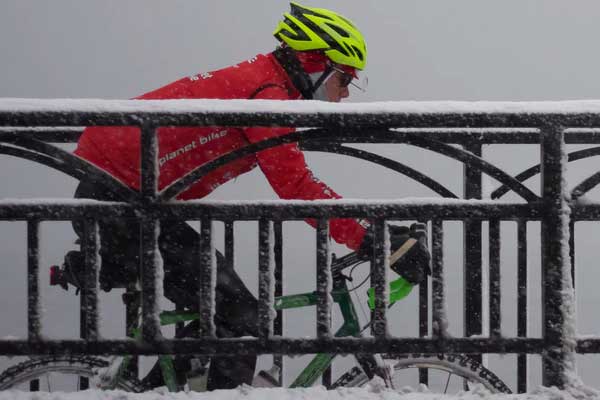
learning the correct pedaling and skills such as descents and cornering technique. Although off-road is slower, the athlete can achieve more in less time (especially in terms of technique). The reason why off-road training is so good for the technique is that riding off-road requires a large number of coordination skills. For example, the athlete is challenged when climbing on a loose surface. He must constantly pedal quite precisely, otherwise the rear wheel slips. Especially in winter, the triathlete should therefore focus on versatility.
As has been shown, the training in the transition phase and in winter has a crucial importance for the coming season. This lays the foundation for the intensive units. However, training in winter is more than a "simple" basic aerobic training. Rather, the aspects described abov
e must be taken into account here in the training plan. In order for this plan to take into account your needs and level of performance, an individualized plan is necessary.
The planning of the training plan should take into account various aspects. You can ask your coach for help or download one of the suitable training plans from our website or Trainingspeaks directly.
Enjoy your winter training.
 EN
EN  DE
DE 


